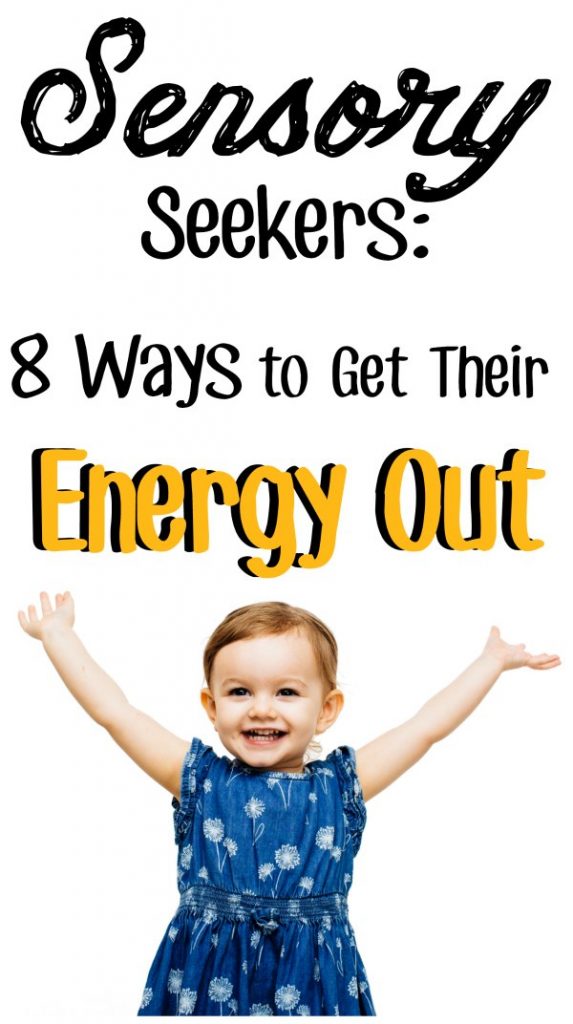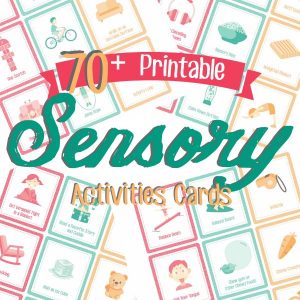Inside you’ll find: Sensory Activities for Sensory Seekers that are extremely easy to do with zero prep and usually zero equipment!
Have you watched your child literally bounce off the walls before?
You might have a sensory seeker on your hands!
If your child is constantly moving, crashing, banging, and chomping, you know the frustration of always finding a way to give your kid an outlet for all that energy!
When kids don’t get the sensory input they crave, they can often seek it out in some rather unpleasant ways.
But who has time to create elaborate sensory activities when your kid is wanting/needing sensory input 24/7?
How can I help my sensory seekers get their energy out?
This post contains affiliate links for your convenience. Please read my full disclosure policy HERE.
1. Jumping
Jumping is a two for the price of one type of sensory activity. The up and down movement of jumping stimulates the inner ear or the vestibular system. The weight on the joints and ligaments in the legs (and all up and down the spine) is WONDERFUL proprioceptive input as well.
Try using an indoor trampoline like this one (like this one) regularly. Or play games that involve jumping, like hopscotch or jump rope.
2. Climbing
When kids climb, their vestibular system is getting lots of input because of the heights and their need for balance. If you’ve even rock climbed, you know how much heavy work ie proprioception goes into the activity as well!
My boys use this Climbing Dome every day in our back yard. It’s crazy sturdy (my entire extended family all got on it at the same time once for a family picture!) and they haven’t grown tired of it after all these years.
They also hang upside down from it. Which leads us too..
3. Inversion
When a child’s head is upside down, it’s referred to as inversion. On top of all the wonderful vestibular input you would expect, inversion empowers a child’s ability to regulate. It can have a calming effect on some kids as well.
For one of my boys, this works like magic. When he is all out of sorts and can’t seem to handle life, upside down we go. He almost always gets an instant smile and his day is turned upside down. Pun intended.
You can do this indoors by letting a child “sit” upside down on a couch and having their head hang off. Or if your kid is small enough, I love to dance with them and purposefully swing them with their head upside down. My son jokes that it helps the happy juice go to his head.
4. Pulling
There’s no need to make sensory activities complicated. Pulling weighted objects is a great way to get sensory input. I like to create sensory activities obstacle courses for my kids and I usually include something they have to pull (their favorite is to pull their brothers around on a blanket across the floor!)
Related: Using Your Furniture as Sensory Equipment
5. Pushing
Similar to pulling, pushing is a simple way to get proprioceptive input. The arms have to work hard to not buckle and the legs are keeping the child stable. I like this sensory activity because it doesn’t require ANY equipment.
Have your child press their palms together in the middle of their chest, like the yoga prayer pose. It might seem like nothing is happening, but your child will be getting the sensory input their body craves. To make it more rambunctious, have your child face you and place your palms flat on hers. With self control, have a “push of war” and see who can make the most ground as you push against each others hands, being sure to keep the arms straight.
6. Running
When kids need a brain break, running is a great choice. While it might seem purely aerobic, there’s actually a lot of sensory input going on too. The movement equals vestibular input. And as the legs pound the ground, the ligaments and joints get plenty of proprioceptive input.
So send your kids for a sprint around the house or a jog up the stairs. Maybe even join them for a game of tag! Keep things fun and full of relationship building moments!
7. Spinning
Have you ever watched a two year old spin themselves silly? Oh the joy! Spinning creates very intense vestibular sensations. So while seekers adore it, be cautious and always follow your child’s lead. Many swings like this one, also we’re made for spinning.
8. Swinging
Swinging in a rocking motion tends to be more calming, though of course that all depends on the swing, the heights to which your child wants to go, and how their sensory systems are functioning at that particular time. The classic playground swing is a great place to get this type of input.
We also love the idea of these Platform Swings so your child can be in a prone position (tummy down).
I hope these simple, time-honored ideas will equip you to always have a sensory activity for your sensory seeker at any given moment. See what your kids enjoy and watch them thrive!
P.S. If you’re wondering what is THE most effective sensory activity to prevent meltdowns with your unique child, take this quick, free, informative quiz. I created it to help you get started in the right direction!
MORE Related Content:
- Helping a Child Who Chews on Everything
- When Kids REFUSE to Do Sensory Activities
- Preventing After School Meltdowns
- 8 Calming Sensory Activities for Free or Cheap
Have more questions??? Check out this wildly popular series of Sensory FAQs and become a more confident sensory parent today!













K says
My friend has a toddler who is constantly putting things in his ears. Could this been a sign of a sensory need or processing issue?